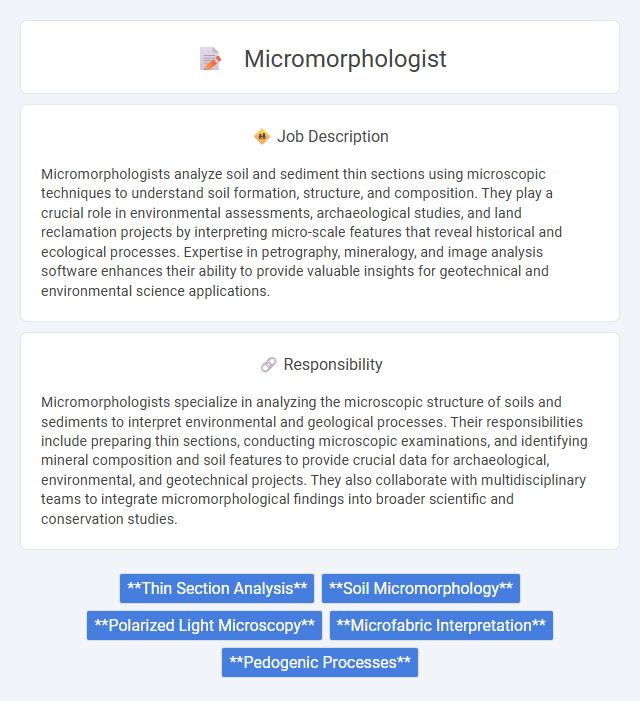
Micromorphologists analyze soil and sediment thin sections using microscopic techniques to understand soil formation, structure, and composition. They play a crucial role in environmental assessments, archaeological studies, and land reclamation projects by interpreting micro-scale features that reveal historical and ecological processes. Expertise in petrography, mineralogy, and image analysis software enhances their ability to provide valuable insights for geotechnical and environmental science applications.
Individuals with a strong attention to detail and a passion for studying microscopic structures are likely well-suited for a micromorphologist role. Those who enjoy working in laboratory settings and possess patience for meticulous analysis may find this job particularly fitting. People who prefer dynamic social interactions over solitary, focused research might encounter challenges adapting to the typical responsibilities of this profession.
Qualification
Micromorphologists typically require a solid foundation in geology, soil science, or environmental science, often holding a bachelor's or master's degree in these fields. Expertise in using advanced microscopy techniques, such as scanning electron microscopy (SEM) and optical petrography, is essential for analyzing soil and sediment structures at a microscopic level. Strong analytical skills combined with experience in sample preparation and interpretation of micromorphological data distinguish qualified candidates in this specialized field.
Responsibility
Micromorphologists specialize in analyzing the microscopic structure of soils and sediments to interpret environmental and geological processes. Their responsibilities include preparing thin sections, conducting microscopic examinations, and identifying mineral composition and soil features to provide crucial data for archaeological, environmental, and geotechnical projects. They also collaborate with multidisciplinary teams to integrate micromorphological findings into broader scientific and conservation studies.
Benefit
Micromorphologists are likely to benefit from specialized expertise in soil and sediment analysis, making them valuable in environmental research and archaeology. Their skill set probably enhances career opportunities in academia, consulting, and resource management sectors. High demand for precise microscopic analysis may lead to competitive salaries and job stability in this niche field.
Challenge
Micromorphologist roles likely involve navigating complex analytical challenges, as they must interpret microscopic soil and sediment structures that require high precision and expertise. The job probably demands advanced knowledge in soil science and microscopy techniques to accurately study and characterize materials at the micro-scale. Overcoming variability in sample conditions and ensuring reproducibility of results may represent ongoing difficulties within this specialized field.
Career Advancement
Micromorphologists specialize in analyzing microscopic features of soils, sediments, and materials to understand their formation and composition, offering valuable insights across environmental and geological industries. Career advancement in micromorphology typically involves progressing from laboratory technician roles to senior scientific positions, research lead, or academic professorships, supported by advanced degrees and publication of significant research. Expertise in microscopy techniques, data interpretation, and interdisciplinary collaboration enhances opportunities for project management, consultancy, and leadership within environmental consulting firms and research institutions.
Key Terms
Thin Section Analysis
Micromorphologists specialize in Thin Section Analysis by examining soil and sediment samples under a microscope to identify microstructures and mineral compositions. This technique provides critical insights into soil formation processes, archaeological site formation, and environmental changes. Expertise in petrographic microscopy and sample preparation enhances the accuracy of interpreting soil microfabric and sedimentary features.
Soil Micromorphology
Soil micromorphologists specialize in analyzing soil at a microscopic level to understand its composition, structure, and formation processes, which is crucial for agriculture, environmental assessment, and land management. They utilize thin section microscopy to examine soil particles, pore spaces, and mineralogy, providing insights into soil fertility, erosion, and contamination. Expertise in soil micromorphology aids in interpreting soil genesis and the impact of human activity on soil health.
Polarized Light Microscopy
Micromorphologists specializing in Polarized Light Microscopy (PLM) analyze the microscopic structure and composition of soils, sediments, and minerals by examining thin sections under polarized light to reveal mineralogical and textural characteristics. This technique enhances the identification of crystalline materials, aiding in the interpretation of geological processes, contamination assessment, and archaeological investigations. Proficiency in PLM allows micromorphologists to deliver detailed insights into the microfabric of samples, supporting environmental studies, land management, and forensic analysis.
Microfabric Interpretation
Micromorphologists specialize in microfabric interpretation by analyzing microscopic sediment structures to reconstruct depositional environments and post-depositional processes. They utilize high-resolution imaging techniques and petrographic analysis to identify mineral composition, grain orientation, and microstructural features that reveal soil formation, weathering, and diagenetic changes. Expertise in microfabric interpretation is essential for archaeology, geology, and environmental studies to understand site formation dynamics and paleoenvironmental conditions.
Pedogenic Processes
Micromorphologists specializing in pedogenic processes analyze soil formation at the microscopic level to identify mineral transformations, organic matter interactions, and microstructural changes. They employ techniques such as thin section analysis and scanning electron microscopy to investigate clay coatings, mineral weathering, and soil horizon development. Their work enhances understanding of soil genesis, fertility, and environmental impacts crucial for agriculture and land management.
 kuljobs.com
kuljobs.com